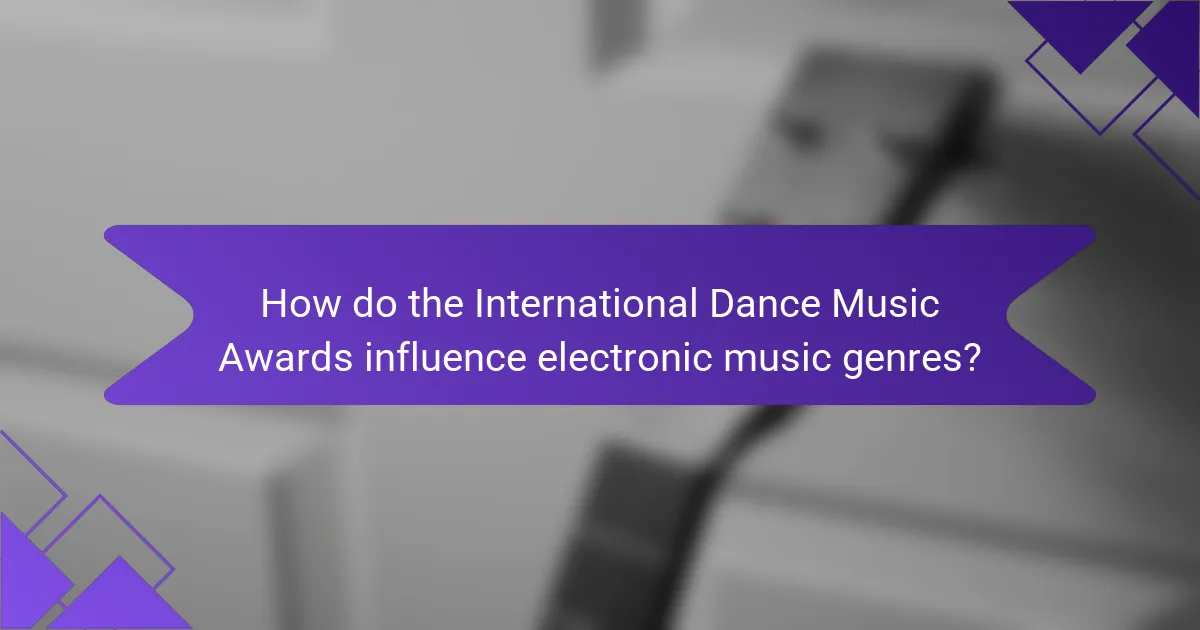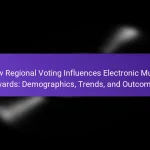The International Dance Music Awards (IDMAs) is an annual event established in 1984 that recognizes excellence in electronic dance music by honoring artists, producers, and tracks across various categories. Held during the Winter Music Conference in Miami, the IDMAs involve a public voting process where fans and industry professionals nominate and vote for their favorites. This awards ceremony not only promotes outstanding talent but also influences electronic music genres by highlighting trends and innovations. Additionally, the IDMAs foster collaboration among artists, contributing to the evolution and diversification of electronic music. The voting process ensures that the awards reflect both fan preferences and industry recognition, culminating in the announcement of winners during the ceremony.

What is the International Dance Music Awards?
The International Dance Music Awards (IDMAs) is an annual event recognizing excellence in electronic dance music. It honors artists, producers, and tracks across various categories. The IDMAs were established in 1984 and have since become a prominent event in the electronic music scene. They are typically held during the Winter Music Conference in Miami. The awards are determined by a public voting process, allowing fans to participate. Categories include Best DJ, Best Producer, and Best Track. The IDMAs play a significant role in promoting electronic music globally. They highlight trends and innovations within the genre.
How did the International Dance Music Awards originate?
The International Dance Music Awards (IDMAs) originated in 1986 as a platform to recognize excellence in electronic music. They were established by the publication “DJ Magazine” to honor artists, producers, and tracks in the dance music genre. The awards aimed to provide a democratic voting process, allowing fans to participate in selecting winners. Over the years, the IDMAs have evolved to include various categories reflecting the diversity of electronic music. The awards have gained international recognition, influencing trends and promoting emerging artists. Their impact has contributed to the growth and legitimacy of electronic music on a global scale.
What were the initial goals of the International Dance Music Awards?
The initial goals of the International Dance Music Awards were to recognize and celebrate achievements in the electronic dance music industry. The awards aimed to provide a platform for artists and producers to gain visibility. They sought to honor various categories, including Best DJ and Best Album. The initiative also aimed to foster community engagement among fans and industry professionals. By establishing these goals, the awards intended to elevate the status of electronic music globally.
How has the purpose of the International Dance Music Awards evolved over time?
The purpose of the International Dance Music Awards has evolved to recognize broader contributions to electronic music. Initially, the awards focused primarily on honoring DJs and producers. Over time, they expanded to include categories for various electronic genres. This change reflects the growing diversity within the electronic music scene. The awards now celebrate innovations in production, artistry, and performance. They also highlight the influence of technology on music creation. The evolution showcases a shift towards inclusivity and recognition of emerging talent. This transformation aligns with the global expansion of electronic music culture.
What categories are included in the International Dance Music Awards?
The International Dance Music Awards include several categories. These categories recognize various aspects of electronic music. They feature awards for Best Dance Artist, Best Dance Track, and Best Compilation Album. Additional categories include Best DJ, Best Live Act, and Best Record Label. Other awards cover genres like House, Trance, and Techno. The awards also honor Best New Artist and Best Remix. Each category aims to celebrate contributions to the electronic music scene. The diversity of categories reflects the broad range of styles within the genre.
Which electronic genres are recognized in the awards?
The electronic genres recognized in the awards include house, techno, trance, and drum and bass. These genres are celebrated for their influence on the electronic music scene. House music is known for its repetitive beats and soulful melodies. Techno emphasizes a faster tempo and synthesized sounds. Trance features melodic phrases and build-ups, creating emotional highs. Drum and bass is characterized by fast breakbeats and heavy bass lines. The International Dance Music Awards highlight these genres annually, showcasing their impact on global music culture.
How are the categories determined for the International Dance Music Awards?
The categories for the International Dance Music Awards are determined through a combination of industry input and audience voting. Industry experts, including DJs and producers, provide insights on emerging trends. The awards also consider the popularity of specific genres and sub-genres within electronic music. Audience participation plays a crucial role in finalizing categories. Fans vote on their favorite artists and tracks, influencing category selection. The awards adapt to reflect changes in music trends and community preferences. This process ensures that the categories remain relevant and representative of the electronic music landscape.

How do the International Dance Music Awards influence electronic music genres?
The International Dance Music Awards (IDMAs) influence electronic music genres by recognizing and promoting outstanding artists and tracks. This recognition elevates the visibility of specific genres within the electronic music scene. Consequently, it can lead to increased popularity and commercial success for the awarded genres. The IDMAs also set trends by highlighting innovative sounds and styles. For example, winners often inspire emerging artists to explore similar musical directions. Additionally, the awards create a platform for collaboration among artists from various genres. This cross-pollination fosters genre evolution and diversification. Overall, the IDMAs play a crucial role in shaping the landscape of electronic music.
What impact do the awards have on genre recognition?
Awards significantly enhance genre recognition within the electronic music landscape. They provide a platform for artists to gain visibility and credibility. Winning or being nominated for awards often leads to increased media attention. This recognition helps define and solidify specific genres in the public consciousness. For example, the International Dance Music Awards spotlight various electronic genres. This spotlighting can lead to a greater understanding and appreciation of those genres. Consequently, awards can influence listener preferences and industry trends. Ultimately, awards play a crucial role in shaping the identity and evolution of electronic music genres.
How do winners influence the popularity of specific electronic genres?
Winners of the International Dance Music Awards significantly influence the popularity of specific electronic genres. Their recognition boosts visibility and credibility within the music industry. Winning an award often leads to increased media coverage and promotional opportunities. This heightened exposure can attract new listeners to the genre. For instance, artists like Calvin Harris and Tiësto have gained massive followings after winning multiple awards. Their success encourages other artists to explore similar styles. Additionally, award-winning tracks often receive more airplay on radio and streaming platforms. This further solidifies the genre’s presence in mainstream music culture.
What role do nominations play in genre visibility?
Nominations significantly enhance genre visibility by recognizing and validating specific music styles. They draw attention to nominated genres, encouraging listeners to explore them. Increased media coverage accompanies nominations, amplifying the reach of these genres. For instance, genres like house and techno gained prominence through consistent nominations at major awards. This recognition can lead to increased sales and streaming numbers. Furthermore, nominations can influence festival lineups, further promoting visibility. Overall, nominations serve as a catalyst for both industry recognition and audience engagement.
How do the awards affect artists and producers in the electronic music scene?
Awards significantly impact artists and producers in the electronic music scene. They enhance visibility and recognition within the industry. Winning an award can lead to increased opportunities for collaboration. It often results in higher demand for performances and bookings. Awards also validate an artist’s work, boosting credibility among peers and fans. Additionally, they can attract sponsorship and funding opportunities. For example, the International Dance Music Awards have historically elevated the profiles of numerous artists. This recognition can lead to career longevity and financial success.
What opportunities arise for artists who win or are nominated?
Winning or being nominated for awards provides significant opportunities for artists. Artists gain increased visibility in the music industry. This visibility can lead to more performance opportunities. Winning can attract the attention of record labels and managers. It can also enhance an artist’s credibility and reputation. Artists often experience a boost in fan engagement following nominations or wins. This engagement can result in higher sales of music and merchandise. Additionally, awards can open doors to collaborations with other renowned artists.
How do the awards shape the careers of emerging artists?
Awards significantly shape the careers of emerging artists by providing recognition and validation. This recognition can lead to increased visibility within the industry. For instance, winning an award can result in more performance opportunities. It can also attract the attention of record labels and promoters. Additionally, awards can enhance an artist’s credibility among peers and fans. According to a study by the National Endowment for the Arts, award-winning artists often experience a 30% increase in bookings post-recognition. This increase in opportunities can accelerate their career growth and establish their presence in competitive markets.

What is the voting process for the International Dance Music Awards?
The voting process for the International Dance Music Awards involves multiple stages. Initially, fans and industry professionals nominate their favorite artists and tracks. This nomination phase typically occurs online through the official awards website. Following the nominations, a voting period is established. During this time, registered users can cast their votes for the nominees in various categories. The voting is usually open to the public, allowing a wide audience to participate. Results are then compiled and verified by the awards committee. The final winners are announced during the awards ceremony. This process ensures that the awards reflect both fan preferences and industry recognition.
Who participates in the voting for the awards?
Voting for the awards is typically conducted by a panel of industry experts. These experts include DJs, producers, and music journalists. Additionally, fans often have the opportunity to vote. This ensures a diverse representation in the voting process. The inclusion of both professionals and fans reflects the industry’s broader community. This voting structure helps to recognize a wide range of talent. It also enhances the credibility of the awards. Overall, the voting participants play a crucial role in shaping the outcome of the awards.
What criteria do voters use to select nominees and winners?
Voters select nominees and winners based on several criteria. Key factors include artistic merit, popularity, and innovation in music. Voters often consider the impact of a nominee’s work on the electronic music scene. Additionally, past achievements and awards influence voter decisions. The voting process may also reflect audience engagement and social media presence. According to industry reports, these criteria help ensure a fair representation of talent and creativity. Ultimately, voters aim to recognize excellence in electronic music through these established benchmarks.
How does public voting influence the outcomes?
Public voting significantly influences the outcomes of the International Dance Music Awards. It allows fans to express their preferences directly. This participation can sway the results toward popular choices. Public votes can amplify the visibility of emerging artists. They create a sense of community engagement among fans. Historically, awards with public voting have shown shifts in genre recognition. For instance, electronic genres have gained traction due to fan support. This dynamic can lead to long-term changes in the music industry landscape.
What challenges does the voting process face?
The voting process faces several challenges that can hinder its effectiveness. Voter suppression is a significant issue, with tactics such as strict ID laws and reduced polling places affecting turnout. Misinformation can also mislead voters about when and how to vote. Accessibility remains a concern, as individuals with disabilities may encounter barriers at polling locations. Additionally, the complexity of ballots can confuse voters, leading to errors. Security threats, including cyberattacks on voting systems, raise concerns about the integrity of the process. These challenges can undermine public confidence in election outcomes, affecting overall participation.
How do controversies affect the credibility of the awards?
Controversies can significantly undermine the credibility of awards. When disputes arise, public perception often shifts negatively. This shift can lead to skepticism regarding the selection process. For instance, if favoritism or bias is alleged, trust in the award’s integrity diminishes. Historical examples show that awards facing backlash often see decreased participation. Additionally, controversies can prompt artists to distance themselves from the awards. This distancing further diminishes the awards’ perceived value. Ultimately, credibility is crucial for awards to maintain relevance in the industry.
What measures are in place to ensure fair voting?
It is not possible to answer the question “


